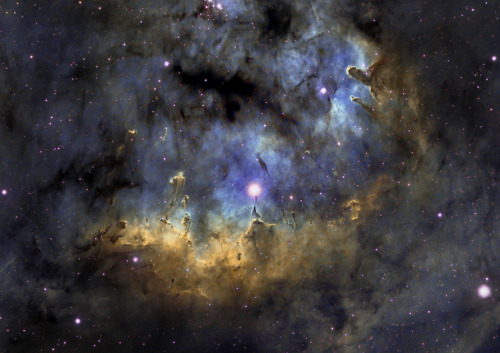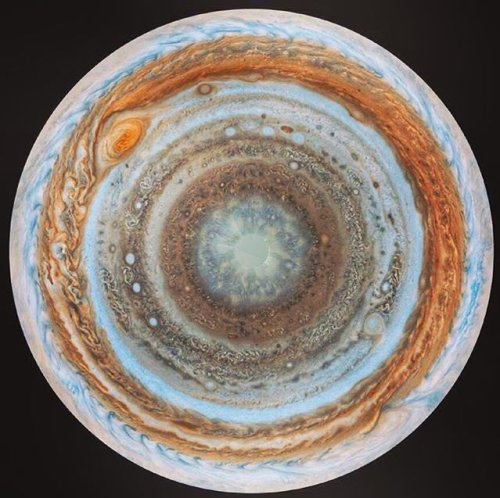Charting The Milky Way From The Inside Out
Charting the Milky Way From the Inside Out
NASA - Wide-field Infrared Survey Explorer (WISE) patch. June 4, 2015
Image above: This artist’s concept depicts the most up-to-date information about the shape of our own Milky Way galaxy. We live around a star, our sun, located about two-thirds of the way out from the center. Image credit: NASA/JPL-Caltech/R. Hurt (SSC/Caltech). Imagine trying to create a map of your house while confined to only the living room. You might peek through the doors into other rooms or look for light spilling in through the windows. But, in the end, the walls and lack of visibility would largely prevent you from seeing the big picture. The job of mapping our own Milky Way galaxy from planet Earth, situated about two-thirds of the way out from the galaxy’s center, is similarly difficult. Clouds of dust permeate the Milky Way, blocking our view of the galaxy’s stars. Today, researchers have a suitable map of our galaxy’s spiral structure, but, like early explorers charting new territory, they continue to patiently and meticulously fill in the blanks. Recently, researchers have turned to a new mapping method that takes advantage of data from NASA’s Wide-field Infrared Survey Explorer, or WISE. Using WISE, the research team has discovered more than 400 dust-shrouded nurseries of stars, which trace the shape of our galaxy’s spiral arms. Seven of these “embedded star clusters” are described in a new study published online May 20 in the Monthly Notices of the Royal Astronomical Society.
Image above: (Annotated) This artist’s concept depicts the most up-to-date information about the shape of our own Milky Way galaxy. We live around a star, our sun, located about two-thirds of the way out from the center. Image credit: NASA/JPL-Caltech/R. Hurt (SSC/Caltech). “The sun’s location within the dust-obscured galactic disk is a complicating factor to observe the galactic structure,” said Denilso Camargo, lead author of the paper from the Federal University of Rio Grande do Sul in Brazil. The results support the four-arm model of our galaxy’s spiral structure. For the last few years, various methods of charting the Milky Way have largely led to a picture of four spiral arms. The arms are where most stars in the galaxy are born. They are stuffed with gas and dust, the ingredients of stars. Two of the arms, called Perseus and Scutum-Centaurus, seem to be more prominent and jam-packed with stars, while the Sagittarius and Outer arms have as much gas as the other two arms but not as many stars. The new WISE study finds embedded star clusters in the Perseus, Sagittarius, and Outer arms. Data from the Two Micron All Sky Survey (2MASS), a ground-based predecessor of WISE from NASA, the National Science Foundation and the University of Massachusetts, Amherst, helped narrow down the distances to the clusters and pinpoint their location. Embedded star clusters are a powerful tool for visualizing the whereabouts of spiral arms because the clusters are young, and their stars haven’t yet drifted away and out of the arms. Stars begin their lives in the dense, gas-rich neighborhoods of spiral arms, but they migrate away over time. These embedded star clusters complement other techniques for mapping our galaxy, such as those used by radio telescopes, which detect the dense gas clouds in spiral arms.
Image above: Astronomers using data from NASA’s Wide-field Infrared Survey Explorer, or WISE, are helping to trace the shape of our Milky Way galaxy’s spiral arms. Image credit: NASA/JPL-Caltech/Federal University of Rio Grande do Sul. “Spiral arms are like traffic jams in that the gas and stars crowd together and move more slowly in the arms. As material passes through the dense spiral arms, it is compressed and this triggers more star formation,” said Camargo. WISE is ideal for finding the embedded star clusters because its infrared vision can cut through the dust that fills the galaxy and shrouds the clusters. What’s more, WISE scanned the whole sky, so it was able to perform a thorough survey of the shape of our Milky Way. NASA’s Spitzer Space Telescope also uses infrared images to map the Milky Way’s territory. Spitzer looks along specific lines of sight and counts stars. The spiral arms will have the densest star populations.
NASA’s Wide-field Infrared Survey Explorer, or WISE. Image Credit: NASA
NASA’s Jet Propulsion Laboratory in Pasadena, California managed and operated WISE for NASA’s Science Mission Directorate in Washington. The spacecraft was put into hibernation mode in 2011, after it scanned the entire sky twice, thereby completing its main objectives. In September 2013, WISE was reactivated, renamed NEOWISE and assigned a new mission to assist NASA’s efforts to identify potentially hazardous near-Earth objects. Other authors of the study are: Charles Bonatto and Eduardo Bica, also with the Federal University of Rio Grande do Sul. For more information on WISE, visit: http://www.nasa.gov/wise Previous research from Camargo’s team found two embedded clusters far outside the plane of our Milky Way, 16,000 light-years away. A feature story about that work is online at: http://www.jpl.nasa.gov/news/news.php?feature=4497 The new WISE study from the Monthly Notices of the Royal Astronomical Society is online at: http://mnras.oxfordjournals.org/content/450/4/4150.full?keytype=ref&ijkey=tjeJAezGAmgdXzc Images (mentioned), Text, Credits: NASA/Felicia Chou/JPL/Whitney Clavin/Tony Greicius. Best regards, Orbiter.ch Full article
More Posts from Xnzda and Others

Solarbeat
This is magical. whitevinyldesign.com/solarbeat
via wired
Because every planet has its own orbital period, “it ends up generating this unending, interesting pattern,” Twyman says. For example, Mercury, which has an orbit of 88 Earth days, is the backbeat to the sound, while Pluto, which takes approximately 248 years to orbit the sun, rarely makes an appearance in the music. “It really lends itself to generating ambient music,” he says. You can tweak the speed of orbit, slowing it down to make a soothing tinkle of a child’s mobile or speeding it up to orchestrate a chaotic planetary choir. New features allow you to add sound effects like echo, flutter and bass, and you can choose from eight different chords to personalize the sound. READ MORE
What Happened to Mars?
Billions of years ago, Mars was a very different world. Liquid water flowed in long rivers that emptied into lakes and shallow seas. A thick atmosphere blanketed the planet and kept it warm.

Today, Mars is bitter cold. The Red Planet’s thin and wispy atmosphere provides scant cover for the surface below.

Our MAVEN Mission
The Mars Atmosphere and Volatile EvolutioN (MAVEN) mission is part of our Mars Scout program. This spacecraft launched in November 2013, and is exploring the Red Planet’s upper atmosphere, ionosphere and interactions with the sun and solar wind.

The purpose of the MAVEN mission is to determine the state of the upper atmosphere of Mars, the processes that control it and the overall atmospheric loss that is currently occurring. Specifically, MAVEN is exploring the processes through which the top of the Martian atmosphere can be lost to space. Scientists think that this loss could be important in explaining the changes in the climate of Mars that have occurred over the last four billion years.
New Findings
Today, Nov. 5, we will share new details of key science findings from our ongoing exploration of Mars during a news briefing at 2 p.m. EDT. This event will be broadcast live on NASA Television. Have questions? Use #askNASA during the briefing.
Make sure to follow us on Tumblr for your regular dose of space: http://nasa.tumblr.com

NASA’s planet-hunting Kepler Telescope has spotted the first roughly Earth-sized world orbiting in the “Goldilocks zone” of another star – offering perhaps the best bet so far for life elsewhere in the universe.
A year on Kepler 452b, which is about 1,400 light years from us in the constellation Cygnus, is 385 days, meaning its orbit is just a bit farther away from its star than the Earth is from the sun. That places it squarely within what planetary scientists call the habitable zone, or “Goldilocks” zone — not too cold and not too hot.
“In my mind, this is the closest planet indeed to Earth,” Jon Jenkins, Kepler data analysis lead at NASA’s Ames Research Center in Moffett Field, Calif, said at a media briefing. “The star is a little bit older and a little bit bigger and brighter, so it’s good that it’s a bit farther from its star.”
Kepler Telescope Introduces Earth To A Very Distant Cousin
Image: Artist’s concept compares Earth (left) to the new planet, called Kepler-452b, which is about 60 percent larger in diameter. Courtesy of NASA/JPL-Caltech/T. Pyle

lesbians in space

The Egg Nebula
The Egg Nebula is approximately 3,000 Light years away from Earth.Resembling a rippling pool illuminated by underwater lights, the Egg Nebula offers astronomers a special look at the normally invisible dust shells swaddling an aging star. These dust layers, extending over one-tenth of a light-year from the star, have an onionskin structure that forms concentric rings around the star.
Image credit: NASA
on the first day of class my astronomy professor asked us why the night sky was dark. if our universe is infinite, how can there be spaces between the stars? he didn’t answer the question until the last day– because our universe is relatively young, and is still growing. it is finite. not enough stars or galaxies have been formed to fill up the entire night sky.
but what that means to me is that somewhere, in an older universe, the night sky looks like a tapestry of diamonds. somewhere darkness is pale white and glittering. imagine being so surrounded. i haven’t gotten that image out of my head ever since– you could never navigate under such a sky but god it sounds lovely

Astronomy Photo of the Day: 5/30/15 — Vividly Blue NGC 7822
This beautifully blue image comes from Manuel Fernández Suarez—an award winning astrophotographer. It provides a window into the heart of a stellar nursery, found approximately 3,000 light-years from Earth in the Cepheus constellation.
Called NGC 7822, it lurks on the outskirts of a behemoth molecular cloud (one of the largest in our galaxy), and contains numerous features, like the star cluster known as Berkeley 59, along with one of the hottest stars in our local part of the galaxy—called BD+66 1673 (there, temperatures can exceed 45,000 K).
As we noted before, “The region, formally known as NGC 7822, contains hundreds of newborn stars that are leaving their own mark on the interstellar material surrounding them, seeding it with heavy elements that will ultimately collapse to give life to a new generation of stars. These same stars are also slowly chipping away at some of the material, they in turn, give it its distinct shape and its designation as an emission nebula.”
Sources & Other Resources: http://bit.ly/1LPOf5M
Image Credit: Manuel Fernández Suarez
-
 xnzda reblogged this · 5 years ago
xnzda reblogged this · 5 years ago -
 underthor reblogged this · 9 years ago
underthor reblogged this · 9 years ago -
 jdr1966 liked this · 9 years ago
jdr1966 liked this · 9 years ago -
 bbafer-franklin liked this · 9 years ago
bbafer-franklin liked this · 9 years ago -
 debunkingthemichelle liked this · 9 years ago
debunkingthemichelle liked this · 9 years ago -
 thosequotesthatinspire reblogged this · 9 years ago
thosequotesthatinspire reblogged this · 9 years ago -
 normalrachelsareboring liked this · 9 years ago
normalrachelsareboring liked this · 9 years ago -
 wannabe-now-blog liked this · 9 years ago
wannabe-now-blog liked this · 9 years ago -
 rebbbbbecca liked this · 9 years ago
rebbbbbecca liked this · 9 years ago -
 tashvi liked this · 9 years ago
tashvi liked this · 9 years ago -
 krystami-blog liked this · 9 years ago
krystami-blog liked this · 9 years ago -
 ayydrein liked this · 9 years ago
ayydrein liked this · 9 years ago -
 dorkymess101-blog-blog reblogged this · 9 years ago
dorkymess101-blog-blog reblogged this · 9 years ago -
 dragonboyteeth liked this · 9 years ago
dragonboyteeth liked this · 9 years ago -
 atrumdeus reblogged this · 9 years ago
atrumdeus reblogged this · 9 years ago -
 all-the-space reblogged this · 9 years ago
all-the-space reblogged this · 9 years ago -
 glitorisfem liked this · 9 years ago
glitorisfem liked this · 9 years ago -
 nephelokokkygia-lost-its-birds liked this · 9 years ago
nephelokokkygia-lost-its-birds liked this · 9 years ago -
 sexuallyfrustratedhouseplant reblogged this · 9 years ago
sexuallyfrustratedhouseplant reblogged this · 9 years ago -
 sexuallyfrustratedhouseplant liked this · 9 years ago
sexuallyfrustratedhouseplant liked this · 9 years ago -
 zeby-zeb-beb liked this · 9 years ago
zeby-zeb-beb liked this · 9 years ago -
 likumiko reblogged this · 9 years ago
likumiko reblogged this · 9 years ago -
 siik-insane liked this · 9 years ago
siik-insane liked this · 9 years ago -
 jacquelinesantiago liked this · 9 years ago
jacquelinesantiago liked this · 9 years ago -
 quasigeostrophy liked this · 9 years ago
quasigeostrophy liked this · 9 years ago -
 bitchyouaintkawaii-inc liked this · 9 years ago
bitchyouaintkawaii-inc liked this · 9 years ago -
 mishiexd liked this · 9 years ago
mishiexd liked this · 9 years ago -
 sleepyreflection liked this · 9 years ago
sleepyreflection liked this · 9 years ago -
 loganvok liked this · 9 years ago
loganvok liked this · 9 years ago -
 aaronstjames reblogged this · 9 years ago
aaronstjames reblogged this · 9 years ago -
 aaronstjames liked this · 9 years ago
aaronstjames liked this · 9 years ago -
 pissle liked this · 9 years ago
pissle liked this · 9 years ago -
 underthor liked this · 9 years ago
underthor liked this · 9 years ago -
 dropthedealers liked this · 9 years ago
dropthedealers liked this · 9 years ago -
 jollyrenegade liked this · 9 years ago
jollyrenegade liked this · 9 years ago -
 plentyofintention liked this · 9 years ago
plentyofintention liked this · 9 years ago -
 93koi liked this · 9 years ago
93koi liked this · 9 years ago -
 yewterus liked this · 9 years ago
yewterus liked this · 9 years ago -
 yewterus reblogged this · 9 years ago
yewterus reblogged this · 9 years ago -
 kinkyjynxy reblogged this · 9 years ago
kinkyjynxy reblogged this · 9 years ago


